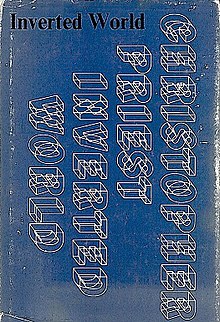
Mars, the fourth planet from the Sun, has appeared as a setting in works of fiction since at least the mid-1600s. Trends in the planet's portrayal have largely been influenced by advances in planetary science. It became the most popular celestial object in fiction in the late 1800s, when it became clear that there was no life on the Moon. The predominant genre depicting Mars at the time was utopian fiction. Around the same time, the mistaken belief that there are canals on Mars emerged and made its way into fiction, popularized by Percival Lowell's speculations of an ancient civilization having constructed them. The War of the Worlds, H. G. Wells's novel about an alien invasion of Earth by sinister Martians, was published in 1897 and went on to have a major influence on the science fiction genre.
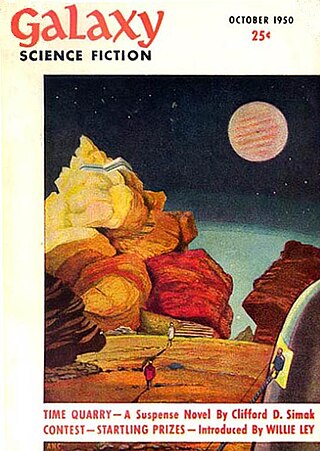
Galaxy Science Fiction was an American digest-size science fiction magazine, published in Boston from 1950 to 1980. It was founded by a French-Italian company, World Editions, which was looking to break into the American market. World Editions hired as editor H. L. Gold, who rapidly made Galaxy the leading science fiction magazine of its time, focusing on stories about social issues rather than technology.
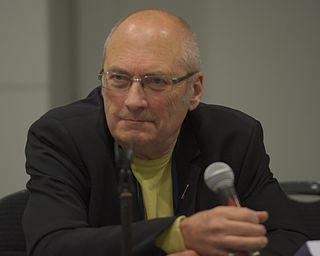
John Frederick Clute is a Canadian-born author and critic specializing in science fiction and fantasy literature who has lived in both England and the United States since 1969. He has been described as "an integral part of science fiction's history" and "perhaps the foremost reader-critic of science fiction in our time, and one of the best the genre has ever known." He was one of eight people who founded the English magazine Interzone in 1982.

Christopher Mackenzie Priest was a British novelist and science fiction writer. His works include Fugue for a Darkening Island (1972), The Inverted World (1974), The Affirmation (1981), The Glamour (1984), The Prestige (1995), and The Separation (2002).
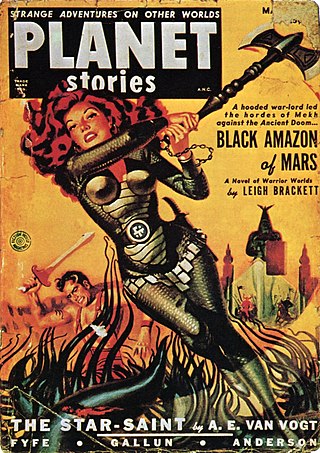
Planet Stories was an American pulp science fiction magazine, published by Fiction House between 1939 and 1955. It featured interplanetary adventures, both in space and on some other planets, and was initially focused on a young readership. Malcolm Reiss was editor or editor-in-chief for all of its 71 issues. Planet Stories was launched at the same time as Planet Comics, the success of which probably helped to fund the early issues of Planet Stories. Planet Stories did not pay well enough to regularly attract the leading science fiction writers of the day, but occasionally obtained work from well-known authors, including Isaac Asimov and Clifford D. Simak. In 1952 Planet Stories published Philip K. Dick's first sale, and printed four more of his stories over the next three years.

Planetary romance is a subgenre of science fiction or science fantasy in which the bulk of the action consists of adventures on one or more exotic alien planets, characterized by distinctive physical and cultural backgrounds. Some planetary romances take place against the background of a future culture where travel between worlds by spaceship is commonplace; others, particularly the earliest examples of the genre, do not, and invoke flying carpets, astral projection, or other methods of getting between planets. In either case, it is the planetside adventures which are the focus of the story, not the mode of travel.
The timestream or time stream is a metaphorical conception of time as a stream, a flowing body of water. In Brave New Words: The Oxford Dictionary of Science Fiction, the term is more narrowly defined as: "the series of all events from past to future, especially when conceived of as one of many such series". Timestream is the normal passage or flow of time and its historical developments, within a given dimension of reality. The concept of the time stream, and the ability to travel within and around it, are the fundamentals of a genre of science fiction.
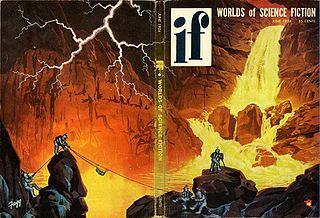
Fictional depictions of Mercury, the innermost planet of the Solar System, have gone through three distinct phases. Before much was known about the planet, it received scant attention. Later, when it was incorrectly believed that it was tidally locked with the Sun creating a permanent dayside and nightside, stories mainly focused on the conditions of the two sides and the narrow region of permanent twilight between. Since that misconception was dispelled in the 1960s, the planet has again received less attention from fiction writers, and stories have largely concentrated on the harsh environmental conditions that come from the planet's proximity to the Sun.

The Separation is a novel by British writer Christopher Priest, published in 2002. It is an alternate history revolving around the experiences of identical twin brothers during the Second World War, during which one becomes a pilot for the RAF, and the other, a conscientious objector, becomes an ambulance driver for the Red Cross. The author introduces a deliberate confusion by giving these brothers identical initials – J.L. Sawyer – one known as Jack and the other as Joe.

Planets outside of the Solar System have appeared in fiction since at least the 1850s, long before the first real ones were discovered in the 1990s. Most of these fictional planets do not differ significantly from the Earth, and serve only as settings for the narrative. The majority host native lifeforms, sometimes with humans integrated into the ecosystems. Fictional planets that are not Earth-like vary in many different ways. They may have significantly stronger or weaker gravity on their surfaces, or have a particularly hot or cold climate. Both desert planets and ocean planets appear, as do planets with unusual chemical conditions. Various peculiar planetary shapes have been depicted, including flattened, cubic, and toroidal. Some fictional planets exist in multiple-star systems where the orbital mechanics can lead to exotic day–night or seasonal cycles, while others do not orbit any star at all. More fancifully, planets are occasionally portrayed as having sentience, though this is less common than stars receiving the same treatment or a planet's lifeforms having a collective consciousness.
There have been many attempts at defining science fiction. This is a list of definitions that have been offered by authors, editors, critics and fans over the years since science fiction became a genre. Definitions of related terms such as "science fantasy", "speculative fiction", and "fabulation" are included where they are intended as definitions of aspects of science fiction or because they illuminate related definitions—see e.g. Robert Scholes's definitions of "fabulation" and "structural fabulation" below. Some definitions of sub-types of science fiction are included, too; for example see David Ketterer's definition of "philosophically-oriented science fiction". In addition, some definitions are included that define, for example, a science fiction story, rather than science fiction itself, since these also illuminate an underlying definition of science fiction.

Black holes, objects whose gravity is so strong that nothing—including light—can escape them, have been depicted in fiction since at least the pulp era of science fiction, before the term black hole was coined. A common portrayal at the time was of black holes as hazards to spacefarers, a motif that has also recurred in later works. The concept of black holes became popular in science and fiction alike in the 1960s. Authors quickly seized upon the relativistic effect of gravitational time dilation, whereby time passes more slowly closer to a black hole due to its immense gravitational field. Black holes also became a popular means of space travel in science fiction, especially when the notion of wormholes emerged as a relatively plausible way to achieve faster-than-light travel. In this concept, a black hole is connected to its theoretical opposite, a so-called white hole, and as such acts as a gateway to another point in space which might be very distant from the point of entry. More exotically, the point of emergence is occasionally portrayed as another point in time—thus enabling time travel—or even an entirely different universe.
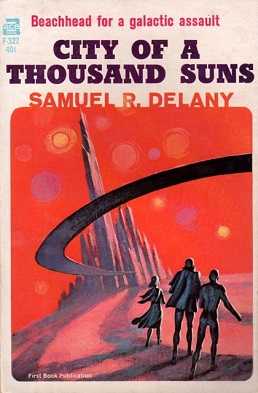
City of a Thousand Suns is a 1965 science fantasy novel by American writer Samuel R. Delany, the final novel in the Fall of the Towers trilogy.

Authentic Science Fiction was a British science fiction magazine published in the 1950s that ran for 85 issues under three editors: Gordon Landsborough, H.J. Campbell, and E.C. Tubb. The magazine was published by Hamilton and Co. in London and began in 1951 as a series of novels appearing every two weeks; by the summer it became a monthly magazine, with readers' letters and an editorial page, though fiction content was still restricted to a single novel. In 1952 short fiction began to appear alongside the novels, and within two more years it completed the transformation into a science fiction magazine.

The Book of Ptath is a science fiction novel by Canadian-American writer A. E. van Vogt. It was first published in book form in 1947 by Fantasy Press in an edition of 3,021 copies. The novel was originally serialized in the magazine Unknown in October 1943. The book has also appeared under the titles Two Hundred Million A.D. and Ptath.
A relatively common motif in speculative fiction is the existence of single-gender worlds or single-sex societies. These fictional societies have long been one of the primary ways to explore implications of gender and gender-differences in science fiction and fantasy. Many of these predate a widespread distinction between gender and sex and conflate the two.

City at the End of Time is a 2008 science fiction novel by American writer Greg Bear. It was published in August 2008 by Del Rey in the United States, and Gollancz in the United Kingdom. The story follows three drifters in present-day Seattle who are tormented by strange dreams of the Kalpa, a city one hundred trillion years in the future. The Kalpa is attempting to ward off the Typhon, an inexplicable entity that has consumed the rest of the ancient universe and broken down the laws of physics.

The Haunted Stars is a science fiction novel by American writer Edmond Hamilton. It tells the story of an expedition from Earth to a planet of the star Altair — a planet called Ryn, inhabited by humans like those on Earth. Against the wishes of Ryn's inhabitants, the team from Earth seek information about weapons technology used in an ancient space war. Their unsuccessful search ends in dramatic contact with another species, the ancient enemy of Ryn.

Carnival is a 2006 science fiction novel by Elizabeth Bear, published in the US by Bantam Spectra. It was nominated for a Philip K. Dick Award, a Locus Award for Best Science Fiction Novel and a Lambda Literary Award.

Voodoo Planet is a science fiction novel by American writer Andre Norton, first published in 1959 by Ace Books. This is a short novel that was usually published in a double-novel format. It is part of the Solar Queen series of novels.
